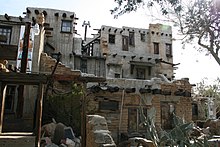Cabot's Pueblo Museum

Pueblo Museum – Main Building
|
|
| Established | 1945 |
|---|---|
| Location |
67-616 East Desert View Ave. |
| Type | Historic house museum |
| Visitors | 10,000+ per year |
| Curator | Cabot's Museum Foundation |
| Public transit access |
SunLine Transit Agency Line 14 |
| Website | www |
67-616 East Desert View Ave.
Desert Hot Springs, California
Cabot's Pueblo Museum (also known as Cabot's Old Indian Pueblo Museum Cabot's Trading Post and Yerxa's Discovery) is a historic house museum located in Desert Hot Springs, California, United States. A large, Hopi-style pueblo, built in the Pueblo Revival Style, it contains artworks, artifacts of American Indian and Alaska Native cultures, and memorabilia of early desert homesteader life.
The house and surrounding structures were self-built by Cabot Abram Yerxa (1883–1965), an early 20th-century homesteader in the Coachella Valley. It is named as "Cabot’s Old Indian Pueblo Museum" in its application for listing on the National Register of Historic Places. The California State Parks Office of Historic Preservation lists it as "Yerxa's Discovery".
Yerxa was an adventurer who first settled on the 160-acre (65-hectare) plot in 1913. Using pick and shovel to dig wells, Yerxa discovered two separate aquifers separated by the Mission Creek Fault (a branch of the San Andreas Fault) atop what would later be called "Miracle Hill." The first aquifer was a natural hot spring with a temperature of 110 °F (43 °C) in the Desert Hot Springs Sub-Basin and which would later help give rise to the area's spas and resorts. The second, on the opposite side of the fault, was a cold aquifer of the Mission Springs Sub-Basin. This same aquifer provides fresh water to the city of Desert Hot Springs and has received awards for exceptional taste.
...
Wikipedia
